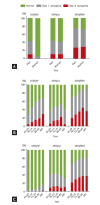Differences among skeletal muscle mass indices derived from height-, weight-, and body mass index-adjusted models in assessing sarcopenia
- PMID: 27334763
- PMCID: PMC4939509
- DOI: 10.3904/kjim.2016.015
Differences among skeletal muscle mass indices derived from height-, weight-, and body mass index-adjusted models in assessing sarcopenia
Abstract
Aging processes are inevitably accompanied by structural and functional changes in vital organs. Skeletal muscle, which accounts for 40% of total body weight, deteriorates quantitatively and qualitatively with aging. Skeletal muscle is known to play diverse crucial physical and metabolic roles in humans. Sarcopenia is a condition characterized by significant loss of muscle mass and strength. It is related to subsequent frailty and instability in the elderly population. Because muscle tissue is involved in multiple functions, sarcopenia is closely related to various adverse health outcomes. Along with increasing recognition of the clinical importance of sarcopenia, several international study groups have recently released their consensus on the definition and diagnosis of sarcopenia. In practical terms, various skeletal muscle mass indices have been suggested for assessing sarcopenia: appendicular skeletal muscle mass adjusted for height squared, weight, or body mass index. A different prevalence and different clinical implications of sarcopenia are highlighted by each definition. The discordances among these indices have emerged as an issue in defining sarcopenia, and a unifying definition for sarcopenia has not yet been attained. This review aims to compare these three operational definitions and to introduce an optimal skeletal muscle mass index that reflects the clinical implications of sarcopenia from a metabolic perspective.
Keywords: Appendicular skeletal muscle mass; Frailty; Muscle mass; Muscle mass index; Sarcopenia.
Conflict of interest statement
No potential conflict of interest relevant to this article was reported.
Figures


References
-
- Frontera WR, Ochala J. Skeletal muscle: a brief review of structure and function. Calcif Tissue Int. 2015;96:183–195. - PubMed
-
- Hughes VA, Frontera WR, Wood M, et al. Longitudinal muscle strength changes in older adults: influence of muscle mass, physical activity, and health. J Gerontol A Biol Sci Med Sci. 2001;56:B209–B217. - PubMed
-
- Cheng Q, Zhu X, Zhang X, et al. A cross-sectional study of loss of muscle mass corresponding to sarcopenia in healthy Chinese men and women: reference values, prevalence, and association with bone mass. J Bone Miner Metab. 2014;32:78–88. - PubMed
Publication types
MeSH terms
LinkOut - more resources
Full Text Sources
Other Literature Sources
Medical
